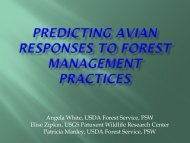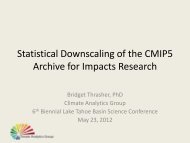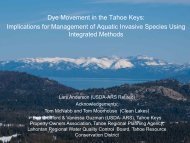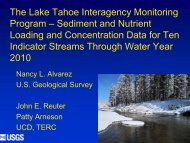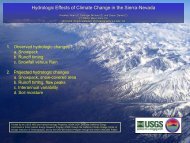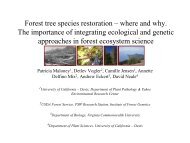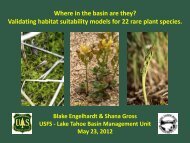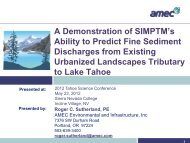Connie Millar, Climate Change Symposium
Connie Millar, Climate Change Symposium
Connie Millar, Climate Change Symposium
You also want an ePaper? Increase the reach of your titles
YUMPU automatically turns print PDFs into web optimized ePapers that Google loves.
Managing for <strong>Climate</strong> and <strong>Climate</strong> Impacts<br />
A Conceptual Framework for<br />
Western Public Lands<br />
<strong>Connie</strong> <strong>Millar</strong><br />
US Forest Service<br />
Sierra Nevada Research Center<br />
Albany & Lee Vining, CA<br />
With Sharon Yeh, Nikola Smith<br />
and Toni Lyn Morelli, USFS
Ecosystems of the Future<br />
Embracing <strong>Change</strong><br />
Accept Uncertainty Yet Certain <strong>Change</strong><br />
as Premises for Decision-Making<br />
Practice ecological management outside the box<br />
- existing management paradigms have limited value<br />
Manage for desired future processes<br />
- ecosystem services writ large
TOOLBOX APPROACH<br />
No single solution fits all cases<br />
Range of options for short & long term<br />
Mix & match tools<br />
Be flexible, experimental (learn-as-yougo),<br />
innovative, bridges kept intact, small<br />
steps, risk-taking, course-correcting<br />
“eggs in one basket” vs “bet-hedging” strategies
Confronting <strong>Climate</strong> <strong>Change</strong><br />
I. Adaptation Strategies<br />
Assist resources & ecosystems to<br />
accommodate changes imposed by<br />
climate<br />
II. Mitigation Strategies<br />
Reduce human effects on climate<br />
by sequestering CO 2 & decreasing<br />
greenhouse gas emissions<br />
Complementary<br />
Conflicting<br />
Strategic & Tactical: 5-R + 1 Strategies<br />
<strong>Millar</strong> et al. 2007. Ecological Applications
“Adaptation” in a climate-change context is<br />
not the same as “Adaptive Management”<br />
As interpreted in forestry contexts, AM<br />
derives from Holling’s classic 1978 book<br />
AM: - implement policy as experiment<br />
- monitor<br />
- learn from monitoring<br />
- adjust policy accordingly<br />
repeat cycle…<br />
E.g., SNAMP
1. Increase Resistance to <strong>Change</strong><br />
“Homeland Security Approach”<br />
Defend high-value resources<br />
against change<br />
BC Forest Service<br />
BC: lodgepole pine &<br />
mountain pine beetle<br />
Carroll et al. 2003<br />
*Adaptation strategy*
Resisting the effects of climate change<br />
might be possible only in the short term<br />
* Lodgepole pine colonization in Tuolomne<br />
Meadows, Yosemite National Park<br />
* Resist projects that may fail or are<br />
inappropriate under future climates<br />
Re-introducing salmon into<br />
warming rivers<br />
Be Aware of “Paddling<br />
Upstream” Decisions<br />
*Adaptation strategy*
2. Promote Resilience to <strong>Change</strong><br />
“Health-Care Approach”<br />
• Improve the capacity of ecosystems to return to prior<br />
conditions after disturbance<br />
• Minimize stress; promote health, alternatives, & surplus<br />
Mgmt Examples<br />
- Thin Forest Stands<br />
- Prescribe Fires<br />
- Stock Seed Banks<br />
- Make Snow at Ski Areas<br />
- Increase Rare Species<br />
Population Targets<br />
*Adaptation strategy*
3. Enable Ecosystems to Respond to<br />
<strong>Change</strong><br />
“Beginner’s Mind Approach”<br />
* Assist Ecosystems to Follow Changing <strong>Climate</strong>s<br />
Use climate projections at coarse scale to plan options<br />
e.g., “off-site” plantations<br />
Lenihan et al. 2006<br />
Beware:<br />
“Eggs-in–One-Basket”<br />
*Adaptation strategy*
Assisted migration<br />
Move germplasm to favorable<br />
location<br />
“The climate models show<br />
little chance that the climate<br />
anywhere in the western US<br />
will be suitable for Brewer<br />
spruce by 2060. However, all<br />
GCMs show suitable climatic<br />
niche in south-eastern Alaska<br />
and coastal British Columbia.<br />
My Canadian colleagues are<br />
planning for genetic resource<br />
planting sites near Prince<br />
Rupert, British Columbia.”<br />
Be wary: A hasty<br />
recommendation?
* Anticipate and Plan for Associated Risks<br />
Forest Dieback; Fires in Subalpine Forests; Off-Season &<br />
Year-Round Fires; Extreme Wind and Flood Events…<br />
3 Sisters Wilderness, OR<br />
2008<br />
Whitebark pine, 9500’, E SN, 2008<br />
Cascade Crest Complex, OR, 2006<br />
Yosemite Valley<br />
Flood, May 2005<br />
Fire at Big Bear Mtn, CA, 2005
* Experiment Creatively & Learn From Experiments<br />
1. Use Redundancy<br />
Spread-the-risk<br />
and bet-hedging<br />
approaches<br />
2. Relax Genetic Management<br />
Guidelines
* Increase Diversity<br />
In the forest…<br />
In resort communities…<br />
* Promote Connected Landscapes<br />
- Larger mgmt units; land trades<br />
- Lower fragmentation<br />
- Higher mgmt decision flexibility<br />
- Continuous riparian zones
4. Realign Conditions to Current Dynamics<br />
“Auto Mechanic’s Approach”<br />
For systems far out of the range of natural variability<br />
this may be a useful restoration approach<br />
“Historic range of variability”<br />
(pre-settlement conditions) as<br />
management target will mostly<br />
be inappropriate<br />
DWP diversions<br />
began<br />
*Adaptation strategy*<br />
Stine 1990<br />
Mono Lake, CA<br />
Aquatic Ecosystem
5. Reduce Greenhouse Gases &<br />
Reduce Ecological Footprint<br />
“Good Samaritan Approach”<br />
•Forestry Sector<br />
- Sequester Carbon<br />
- Reduce Emissions<br />
•Energy Sector –<br />
Conservation & Alternative Energy<br />
Barnett<br />
*Mitigation strategy*
Policy & Carbon Management California-Style<br />
AB-32, The California Global-Warming Solutions Act<br />
Signed 27 September 2007 by Governor Schwarzenegger<br />
• Mandates statewide reduction of greenhouse gases to<br />
1990 levels by 2020<br />
• Forestry sector could provide ~18% of needed<br />
reduction in total tons carbon<br />
Sources of Potential<br />
Reductions of 187.2<br />
MMT CO 2 by 2020
Overall: Setting Priorities<br />
Management<br />
Decisions<br />
Do Nothing:<br />
No Advance Action<br />
Be Proactive:<br />
Act in Advance<br />
React after Disturbance<br />
or Extreme Events
Tiered Approaches to Priority Setting<br />
From Amy Luers & Susi Moser, 2006<br />
I. “No Regrets” - Actions that provide benefits in current<br />
and future climate conditions even if no climate change<br />
occurs<br />
II. “Low Regrets” - Actions that provide important<br />
benefits at relatively little additional cost or risk<br />
III.“Win-Win” - Actions that reduce the impacts of climate<br />
change while providing other benefits
Triage Approaches to Priority-Setting<br />
triare (Fr): to sort<br />
Condor: Should<br />
it be sorted red<br />
or black?<br />
TRIAGE Categories:<br />
Red<br />
Urgent, treatable:<br />
immediate priority<br />
Yellow Mid urgency; soon<br />
to become red<br />
Green Stable, low priority<br />
Black Urgent, untreatable<br />
with available resources:<br />
no action<br />
*************************<br />
Re-assess & re-sort
Taking these ideas to the ground…<br />
U.S. <strong>Climate</strong> <strong>Change</strong> Science Program:<br />
2008 SAP 4.4 Reports<br />
www.climatescience.gov/Library/sap/sap4-4/final-report/
Two Case Studies on National Forests 2006+<br />
Tahoe National Forest (CA) & Olympic National Forest (WA)<br />
Challenges & Barriers<br />
Checkerboard ownership<br />
Existing environmental laws<br />
Crisis reaction<br />
Agency target and reward system<br />
Small landscape management units<br />
Opportunities<br />
Rapid assessments of existing plans<br />
Pilot for USFS ecosystem services<br />
Disturbance-event recovery<br />
Policy flexibility<br />
Public education<br />
Needs<br />
Integrated management practices<br />
Case studies & demonstrations<br />
Prioritization tools<br />
Clearing house on science information
Next Phase: Stocking the Toolkit<br />
CLIMATE TOOLKIT PROJECT<br />
<strong>Millar</strong>, Joyce, Nielson, Peterson, et al. (USFS Western Research Stations): 2008-2010<br />
Tools for resource planning at short,<br />
mid, and long-term scales:<br />
-- Access to Relevant Science<br />
-- Evaluate Existing Paradigms<br />
-- Scenario & Uncertainty Exercises<br />
-- Tools for Resource Planning<br />
Case Studies on Sierran National Forests<br />
and National Parks:<br />
- Tahoe NF (Sharon Yeh & Nikola Smith)<br />
- Devils Postpile NM (Deanna Dulen)<br />
- Inyo NF (Toni Lyn Morelli)
Web Tools for Forest Managers:<br />
The USFS “<strong>Climate</strong> <strong>Change</strong> Resource Center”<br />
A one-stop reference website for USFS (& other) managers (Michael Furniss)<br />
http://www.fs.fed.us/ccrc/
Devils Postpile National Monument: A Pilot Study<br />
Incorporating <strong>Climate</strong> into the New GMP:<br />
Manage DEPO as a Refugium Park --<br />
A “Resistance” Strategy<br />
What Role:<br />
Cold-air Pooling &<br />
Biodiversity Hotspot?
Complex Climatology Rules in Mountains<br />
Cold-air pooling (CAP) & inversions<br />
are common, and define widely varying<br />
lapse rates from positive to negative<br />
Atmospheric conditions for CAP<br />
may increase in the future and<br />
overwhelm regional warming<br />
HJ Andrews Forest, OR; Daly 2008<br />
Down is often colder
Upper San Joaquin Watershed;<br />
“Icebox Canyon”<br />
Minarets<br />
Mono Lk<br />
Mammoth<br />
Mtn<br />
DEPO<br />
temp °C<br />
Dettinger 2008
Modeled Cold-Air Pooling and Drainage, DEPO<br />
DEPO<br />
White/gray areas are modeled CAP/CAD<br />
Will CAP increase under future conditions???<br />
Lundquist, Westfall, Forsyth, 2008
What Does a CAP-Refugium<br />
Imply for DEPO Management?<br />
Preserve Current Biodiversity & Ecologic Functions<br />
Mmt Goals<br />
Maintain wet meadows<br />
Mgmt Actions<br />
Remove invading lodgepole pines<br />
Limit use of meadow during wet seasons<br />
Maintain fens, sprgs, wetlands Constrain groundwater pumping<br />
Minimize invasives<br />
Maintain current veg types<br />
Educate visitors<br />
Manually remove invasives<br />
Treat exotic insect & disease outbreaks<br />
Reforestation & restoration guides<br />
remain as status quo<br />
Interpret CAP in context of climate change<br />
Maintain mgmt effectiveness<br />
as climate changes<br />
Intensively monitor climate- and CAP
Inyo National Forest: Pilot Study<br />
Forest Plan Revisions<br />
* Jan 13, 2009 Chief’s Considerations<br />
- Address climate issues as “need for change from current direction”<br />
How will <strong>Climate</strong> <strong>Change</strong> Modify Conditions?<br />
Uncertainty in climate projections requires that defensible geographic<br />
scale will be much broader than appropriate for planning scale<br />
* Strategic Actions for ‘Comprehensive Evaluation Report ‘<br />
- What are risks and vulnerabilities?<br />
- Consider potential ecological adaptations<br />
How can Management Adapt and Adjust?
Specific <strong>Climate</strong> Vulnerabilities: Aspen Decline<br />
Toni Lyn Morelli, David Burton
A New & Distinct Threat? Sudden Aspen Decline/Dieback<br />
(SAD) Appearing in SW Colorado after 2006…<br />
Predisposing Factors<br />
• Old-age stands<br />
• S/SW aspects<br />
• Low-mid elevations<br />
Climatic Factors<br />
• Drought<br />
• Warming<br />
Secondary Factors<br />
• Insects, pathogens<br />
San Juan Mtns , CO<br />
Photo A. Watkins<br />
Photo P. Kemp
SAD has not risen on the radar in the Sierra Nevada<br />
…not occurring here (yet)?<br />
…not recognized?<br />
…insects/disease different?<br />
…little aspen monitoring?<br />
Important to detect because treatment likely<br />
differs from general aspen health management<br />
SAD? Sierra Nevada, Mono Co<br />
?<br />
Early Detection<br />
- thinning, fires, livestock exclusion<br />
Late Detection<br />
- root death means no sprouting, thus<br />
stand treatments are ineffective<br />
Incorporating SAD detection guidelines into SN Aspen Monitoring Protocols<br />
Assessing climate relationships of Inyo NF aspen inventory with PRISM
Managing In The Face of <strong>Change</strong><br />
A Toolbox of Options<br />
Adaptation Strategies<br />
* Practice Resistance<br />
* Increase Resilience<br />
* Allow Forests to Respond<br />
* Realign Highly Altered Ecosystems<br />
Mitigation Strategies<br />
* Reduce Greenhouse Gases & Ecologic Footprint<br />
Overall<br />
* Set Priorities (Tiered,Triage,Vulnerabilities)<br />
* Evaluate Existing Projects<br />
* Assess Projected <strong>Change</strong>s<br />
* Set New Mid- & Longterm Objectives<br />
* Revise Exisiting Plans
For more information & pdf copies of<br />
publications & presentations:<br />
www.fs.fed.us/psw/programs/snrc/staff/millar/<br />
<strong>Climate</strong> <strong>Change</strong> Resource Center:<br />
www.fs.fed.us/ccrc/



